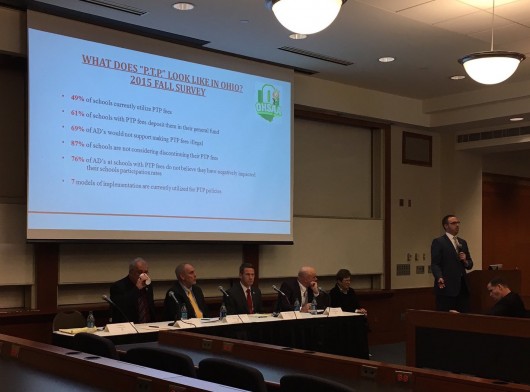
Members of five-man panel speak at an open forum, titled “Pay to Play: Who’s In, Who’s Out and How Much?” speak on Friday. Credit: Nick Clarkson | Lantern reporter
A five-man panel, ranging from professors to politicians, gathered Friday on the Ohio State campus for a forum focused on pay-to-play in high school athletics and ways to improve policy within Ohio schools.
The group presented a multitude of information and statistics in order to develop ways to tackle this statewide issue. The forum, titled “Pay to Play: Who’s In, Who’s Out and How Much?”
was hosted by OSU’s Sports and Society Initiative, a recently created collective of professors conducting research on the crossroads of sports and economics.
It was moderated by Lucia Dunn, an OSU economics professor and co-director of SSI.
Ohio Secretary of State Jon Husted was on the panel, and he spoke about how pay-to-play fees affect families, while stressing how vital it is for young men and women to participate in athletics.
“Extracurricular activities are some of the most important experiences young people can have in life,” Husted said. “I would not be secretary of state, or even successful for that matter, without access to sports.”
Another member of the panel was Scott Grant, an assistant professor of business and the director of sports and event management at the University of Findlay. Grant presented information he gathered from a survey he conducted during the 2014-15 school year across 822 member schools of the Ohio High School Athletic Association.
His findings featured numbers relating to play-to-play fees in Ohio schools. The results showed that 49 percent of schools currently charge the fees, and 87 percent are not considering discontinuing those fees.
The highest family charge per year in one Ohio school is around $1,600, while the heaviest individual charge per year is nearly $1,200, Grant found.
“There is not a one size fits all (solution),” said Sen. Cliff Hite, R-Findlay.
Hite said there are complications in solving the issue because the state treasury feels it having more control might be the most effective way to curb costs. Contrarily, schools would like the state to stay away.
Representing the OHSAA, the governing body for high school athletics, on the panel was Jerry Snodgrass, the association’s assistant commissioner. He said the fear is that the higher pay-to-play fees are, the more likely an athlete will specialize in one sport or play on a club team.
“Club sports have exploded in Ohio, and it’s all about winning,” Snodgrass said. “(OHSAA) is not about that. (OHSAA) is about participation.”
Husted proceeded to focus on the effects of pay-to-play fees on Ohio families and how they present a large obstacle for some students to partake in extracurricular activities.
“Pay-to-play information may not be new, but what is new is what is happening to our children, and our families in the United States,” Husted said. “The middle class is shrinking, and more children are growing up in poverty.”
In Ohio last year, Husted said 53 percent of children born had their births paid for by Medicaid, while nearly 40 percent were born to a single mother living in poverty.
“(The discussion) is about the kids who are going to get lost in the cracks, the ones nobody are looking out for, and are on the slightest barrier between being engaged and not,” the secretary of state said. “We all have to be aligned with helping these kids.”
As a result of the event, the discussion surrounding pay-to-play fees in Ohio could be growing rapidly. The current models and policies of these fees will continue to be debated, and school administrators will work to find a solution, the panel said.
“(Pay-to-play) is a barrier for kids who want to participate,” Husted said. “(The panel is) going to continue to create awareness about (pay-to-play fees), and try to get (schools) to understand that they have an obligation to give kids these experiences.”
SSI is scheduled to host a separate panel discussion on April 15 to explore the highly debated topic of compensation for collegiate student-athletes. The forum is set to feature a number of sports experts and OSU alumni, including Vince Doria, the former senior vice president and director of news at ESPN.


